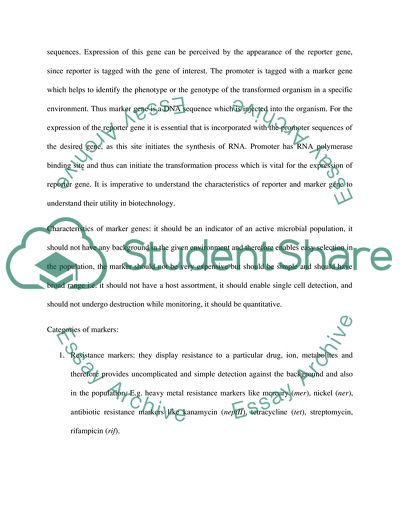Cite this document
(Great Role of the Study and Use in Medicine of Marker and Reporter Gen Term Paper, n.d.)
Great Role of the Study and Use in Medicine of Marker and Reporter Gen Term Paper. Retrieved from https://studentshare.org/science/1731866-using-examples-describe-and-discuss-the-use-of-marker-and-reporter-genes-in-environmental-biotechnology-critically-evaluate-the-relevance-of-marker-and-reporter-gene-technology-in-futrue-research-in-this-discipline
Great Role of the Study and Use in Medicine of Marker and Reporter Gen Term Paper. Retrieved from https://studentshare.org/science/1731866-using-examples-describe-and-discuss-the-use-of-marker-and-reporter-genes-in-environmental-biotechnology-critically-evaluate-the-relevance-of-marker-and-reporter-gene-technology-in-futrue-research-in-this-discipline
(Great Role of the Study and Use in Medicine of Marker and Reporter Gen Term Paper)
Great Role of the Study and Use in Medicine of Marker and Reporter Gen Term Paper. https://studentshare.org/science/1731866-using-examples-describe-and-discuss-the-use-of-marker-and-reporter-genes-in-environmental-biotechnology-critically-evaluate-the-relevance-of-marker-and-reporter-gene-technology-in-futrue-research-in-this-discipline.
Great Role of the Study and Use in Medicine of Marker and Reporter Gen Term Paper. https://studentshare.org/science/1731866-using-examples-describe-and-discuss-the-use-of-marker-and-reporter-genes-in-environmental-biotechnology-critically-evaluate-the-relevance-of-marker-and-reporter-gene-technology-in-futrue-research-in-this-discipline.
“Great Role of the Study and Use in Medicine of Marker and Reporter Gen Term Paper”, n.d. https://studentshare.org/science/1731866-using-examples-describe-and-discuss-the-use-of-marker-and-reporter-genes-in-environmental-biotechnology-critically-evaluate-the-relevance-of-marker-and-reporter-gene-technology-in-futrue-research-in-this-discipline.


